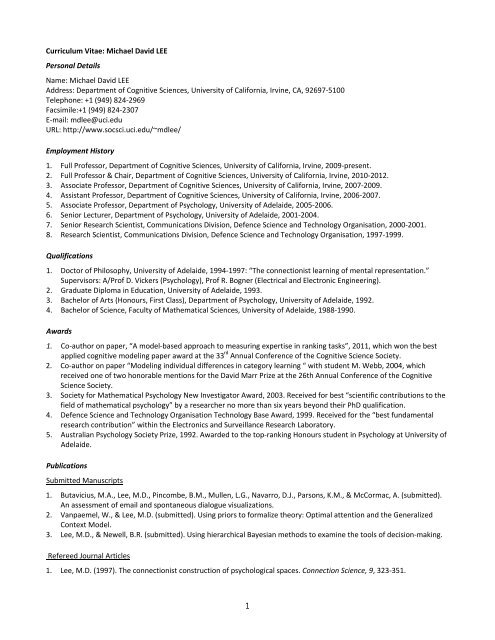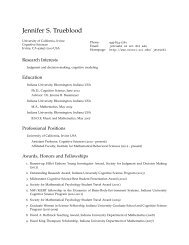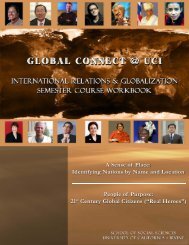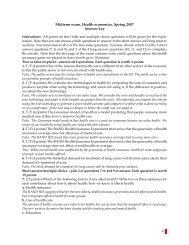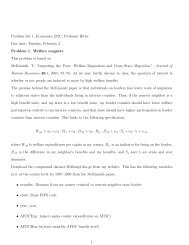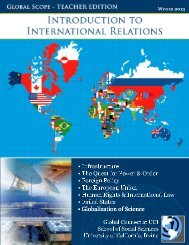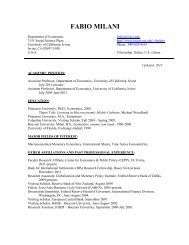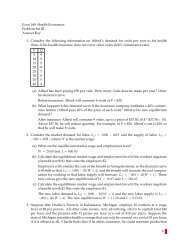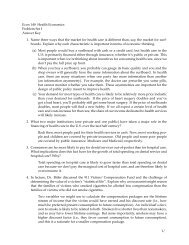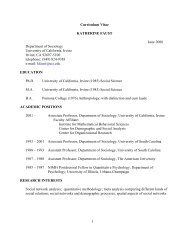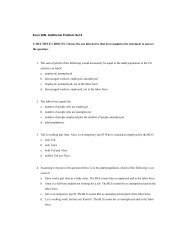Curriculum Vitae: Michael David LEE Personal Details Name ...
Curriculum Vitae: Michael David LEE Personal Details Name ...
Curriculum Vitae: Michael David LEE Personal Details Name ...
Create successful ePaper yourself
Turn your PDF publications into a flip-book with our unique Google optimized e-Paper software.
<strong>Curriculum</strong> <strong>Vitae</strong>: <strong>Michael</strong> <strong>David</strong> <strong>LEE</strong><br />
<strong>Personal</strong> <strong>Details</strong><br />
<strong>Name</strong>: <strong>Michael</strong> <strong>David</strong> <strong>LEE</strong><br />
Address: Department of Cognitive Sciences, University of California, Irvine, CA, 92697‐5100<br />
Telephone: +1 (949) 824‐2969<br />
Facsimile:+1 (949) 824‐2307<br />
E‐mail: mdlee@uci.edu<br />
URL: http://www.socsci.uci.edu/~mdlee/<br />
Employment History<br />
1. Full Professor, Department of Cognitive Sciences, University of California, Irvine, 2009‐present.<br />
2. Full Professor & Chair, Department of Cognitive Sciences, University of California, Irvine, 2010‐2012.<br />
3. Associate Professor, Department of Cognitive Sciences, University of California, Irvine, 2007‐2009.<br />
4. Assistant Professor, Department of Cognitive Sciences, University of California, Irvine, 2006‐2007.<br />
5. Associate Professor, Department of Psychology, University of Adelaide, 2005‐2006.<br />
6. Senior Lecturer, Department of Psychology, University of Adelaide, 2001‐2004.<br />
7. Senior Research Scientist, Communications Division, Defence Science and Technology Organisation, 2000‐2001.<br />
8. Research Scientist, Communications Division, Defence Science and Technology Organisation, 1997‐1999.<br />
Qualifications<br />
1. Doctor of Philosophy, University of Adelaide, 1994‐1997: “The connectionist learning of mental representation.”<br />
Supervisors: A/Prof D. Vickers (Psychology), Prof R. Bogner (Electrical and Electronic Engineering).<br />
2. Graduate Diploma in Education, University of Adelaide, 1993.<br />
3. Bachelor of Arts (Honours, First Class), Department of Psychology, University of Adelaide, 1992.<br />
4. Bachelor of Science, Faculty of Mathematical Sciences, University of Adelaide, 1988‐1990.<br />
Awards<br />
1. Co‐author on paper, “A model‐based approach to measuring expertise in ranking tasks”, 2011, which won the best<br />
applied cognitive modeling paper award at the 33 rd Annual Conference of the Cognitive Science Society.<br />
2. Co‐author on paper “Modeling individual differences in category learning “ with student M. Webb, 2004, which<br />
received one of two honorable mentions for the <strong>David</strong> Marr Prize at the 26th Annual Conference of the Cognitive<br />
Science Society.<br />
3. Society for Mathematical Psychology New Investigator Award, 2003. Received for best “scientific contributions to the<br />
field of mathematical psychology” by a researcher no more than six years beyond their PhD qualification.<br />
4. Defence Science and Technology Organisation Technology Base Award, 1999. Received for the “best fundamental<br />
research contribution” within the Electronics and Surveillance Research Laboratory.<br />
5. Australian Psychology Society Prize, 1992. Awarded to the top‐ranking Honours student in Psychology at University of<br />
Adelaide.<br />
Publications<br />
Submitted Manuscripts<br />
1. Butavicius, M.A., Lee, M.D., Pincombe, B.M., Mullen, L.G., Navarro, D.J., Parsons, K.M., & McCormac, A. (submitted).<br />
An assessment of email and spontaneous dialogue visualizations.<br />
2. Vanpaemel, W., & Lee, M.D. (submitted). Using priors to formalize theory: Optimal attention and the Generalized<br />
Context Model.<br />
3. Lee, M.D., & Newell, B.R. (submitted). Using hierarchical Bayesian methods to examine the tools of decision‐making.<br />
Refereed Journal Articles<br />
1. Lee, M.D. (1997). The connectionist construction of psychological spaces. Connection Science, 9, 323‐351.<br />
1
<strong>Curriculum</strong> <strong>Vitae</strong>: <strong>Michael</strong> <strong>David</strong> <strong>LEE</strong>, 4-November-2011<br />
2. Lee, M.D., Vickers, D., & Brown, M. (1997). Neural network and tree search algorithms for the generation of pathfollowing<br />
(trail making) tests. Journal of Intelligent Systems, 7, 117‐143.<br />
3. Vickers, D., & Lee, M.D. (1997). Towards a dynamic connectionist model of memory. Behavioral and Brain Sciences,<br />
20, 40‐41.<br />
4. Lee, M.D. (1998). Neural feature abstraction from judgments of similarity. Neural Computation, 10, 1815‐1830.<br />
5. Vickers, D., & Lee, M.D. (1998). Dynamic models of simple judgments: I. Properties of a self‐regulating accumulator<br />
module. Non‐linear Dynamics, Psychology, and Life Sciences, 2, 169‐194.<br />
6. Vickers, D., & Lee, M.D. (1998). Never cross the path of a traveling salesman: The neural network generation of<br />
Halstead‐Reitan trail making tests. Behavior Research, Methods, Instruments, & Computers, 30, 423‐431.<br />
7. Lee, M.D. (1999). An extraction and regularization approach to additive clustering. Journal of Classification, 16, 255‐<br />
281.<br />
8. Lee, M.D., & Vickers, D. (2000). The importance of the convex hull for human performance on the traveling salesman<br />
problem: Comment on Macgregor & Ormerod (1996). Perception & Psychophysics, 62, 226‐228.<br />
9. Vickers, D., & Lee, M.D. (2000). Dynamic models of simple judgments: II. Properties of a Parallel, Adaptive,<br />
Generalised Accumulator Network (PAGAN) model for multi‐choice tasks. Non‐linear Dynamics, Psychology, and Life<br />
Sciences, 4, 1‐31.<br />
10. Lee, M.D. (2001). On the complexity of additive clustering models. Journal of Mathematical Psychology, 45, 131‐148.<br />
11. Lee, M.D. (2001). Determining the dimensionality of multidimensional scaling models for cognitive modeling. Journal<br />
of Mathematical Psychology, 45, 149‐166.<br />
12. Lee, M.D. (2001). Extending Bayesian concept learning to deal with representational complexity and adaptation.<br />
Behavioral and Brain Sciences, 24, 685‐686.<br />
13. Vickers, D., Butavicius, M.A., Lee, M.D., & Medvedev, A. (2001). Human performance on visually presented traveling<br />
salesman problems. Psychological Research, 65, 34‐45.<br />
14. Lee, M.D. (2002). A simple method for generating additive clustering models with limited complexity. Machine<br />
Learning, 49, 39‐58.<br />
15. Lee, M.D. (2002). Generating additive clustering models with limited stochastic complexity. Journal of Classification,<br />
19, 69‐85.<br />
16. Lee, M.D., Loughlin, N., & Lundberg, I.B. (2002). Applying one reason decision making: The prioritization of literature<br />
searches. Australian Journal of Psychology, 54, 137‐143.<br />
17. Lee, M.D., & Navarro, D.J. (2002). Extending the ALCOVE model of category learning to featural stimulus domains.<br />
Psychonomic Bulletin & Review, 9, 43‐58.<br />
18. Lee, M.D., & Corlett, E.Y. (2003). Sequential sampling models of human text classification. Cognitive Science, 27, 159‐<br />
193.<br />
19. Lee, M.D., & Pope, K.J. (2003). Avoiding the dangers of averaging across subjects when using multidimensional scaling.<br />
Journal of Mathematical Psychology, 47, 32‐46.<br />
20. Lee, M.D., Butavicius, M.A., & Reilly, R.E. (2003). Visualizations of binary data: A comparative evaluation. International<br />
Journal of Human‐Computer Studies, 59, 569‐602.<br />
21. Vickers, D., Bovet, P., Lee, M.D., & Hughes, P. (2003). The perception of minimal structures: Performance on open and<br />
closed versions of visually presented Euclidean Traveling Salesperson problems. Perception, 32, 871‐886.<br />
22. Vickers, D., Lee, M.D., Dry, M., & Hughes, P. (2003). The roles of the convex hull and number of intersections upon<br />
performance on visually presented traveling salesperson problems. Memory & Cognition, 31, 1094‐1104.<br />
23. Vickers, D., Mayo, T., Heitman, M., Lee, M.D., & Hughes, P. (2004). Intelligence and individual differences in<br />
performance on three types of visually presented optimisation problems. <strong>Personal</strong>ity and Individual Differences, 36,<br />
1059‐1071.<br />
24. Lee, M.D., & Cummins, T.D.R. (2004). Evidence accumulation in decision making: Unifying the ‘take the best’ and<br />
‘rational’ models. Psychonomic Bulletin & Review, 11(2), 343‐352.<br />
25. Lee, M.D. (2004). A Bayesian analysis of retention functions. Journal of Mathematical Psychology, 48, 310‐321.<br />
26. Navarro, D.J., & Lee, M.D. (2004). Common and distinctive features in stimulus representation: A modified version of<br />
the contrast model. Psychonomic Bulletin & Review, 11, 961–974.<br />
27. Lee, M.D., & Wagenmakers, E.J. (2005). Bayesian statistical inference in psychology: Comment on Trafimow (2003).<br />
Psychological Review, 112, 662‐668.<br />
28. Mackay, M., & Lee, M.D., (2005). Choice of models for the analysis and forecasting of hospital beds. Health Care<br />
Management Science Journal, 8, 221‐230.<br />
2
<strong>Curriculum</strong> <strong>Vitae</strong>: <strong>Michael</strong> <strong>David</strong> <strong>LEE</strong>, 4-November-2011<br />
29. Lee, M.D., & Webb, M.R. (2005). Modeling individual differences in cognition. Psychonomic Bulletin & Review, 12,<br />
605‐621.<br />
30. Vickers, D., Lee, M.D., Dry, M., Hughes, P., & McMahon, J.A. (2006). The aesthetic appeal of minimal structures:<br />
Judging the attractiveness of solutions to Traveling Salesperson problems. Perception & Psychophysics, 68, 32‐42.<br />
31. Navarro, D.J., Griffiths, T.L., Steyvers, M., & Lee, M.D. (2006). Modeling individual differences with Dirichlet processes.<br />
Journal of Mathematical Psychology, 50, 101‐102.<br />
32. Lee, M.D., & Pope, K.J. (2006). Model selection for the rate problem: A comparison of significance testing, Bayesian,<br />
and minimum description length statistical inference. Journal of Mathematical Psychology, 50, 193‐202.<br />
33. Lee, M.D. (2006). A hierarchical Bayesian model of human decision‐making on an optimal stopping problem. Cognitive<br />
Science, 30, 555‐580.<br />
34. Burns, N.R., Lee, M.D., & Vickers, D. (2006). Are individual differences in performance on perceptual and cognitive<br />
optimization problems determined by general intelligence? Journal of Problem Solving, 1, 5‐19.<br />
35. Dry, M.J., Lee, M.D., Vickers, D., & Hughes, P. (2006). Human performance on visually presented traveling salesperson<br />
problems with varying numbers of nodes. Journal of Problem Solving, 1, 20‐32.<br />
36. Lee, M.D., & Dry, M.J. (2006). Decision‐making and confidence given uncertain advice. Cognitive Science, 30, 1081‐<br />
1095.<br />
37. Butavicius, M.A., & Lee, M.D. (2007). An empirical evaluation of four data visualization techniques for displaying short<br />
news text similarities. International Journal of Human‐Computer Studies, 65, 931‐944.<br />
38. Malhotra, V., Lee, M.D., & Khurana, A.K. (2007). Domain experts influence decision quality: Towards a robust method<br />
for their identification. Journal of Petroleum Science and Engineering, 57, 181‐194.<br />
39. Lee, M.D., & Paradowski, M.J. (2007). Group performance on an optimal stopping problem. Journal of Problem<br />
Solving, 1, 53‐73.<br />
40. Lee, M.D. (2008). Three case studies in the Bayesian analysis of cognitive models. Psychonomic Bulletin & Review, 15,<br />
1‐15.<br />
41. Fletcher, K.I., Butavicius, M.A., & Lee, M.D. (2008). Attention to internal features in unfamiliar face matching. British<br />
Journal of Psychology, 99, 379‐394.<br />
42. Lee, M.D. (2008). BayesSDT: Software for Bayesian inference with signal detection theory. Behavior Research<br />
Methods, 40, 450‐456.<br />
43. Lee, M.D., & Vanpaemel, W. (2008). Exemplars, prototypes, similarities and rules in category representation: An<br />
example of hierarchical Bayesian analysis. Cognitive Science, 32, 1403‐1424.<br />
44. Chronicle, E.P., MacGregor, J.N., Lee, M.D., Ormerod, T.C., & Hughes, P. (2008). Individual differences in optimization<br />
problem solving: Reconciling conflicting results. Journal of Problem Solving, 2, 41‐49.<br />
45. Dennis, S.J., Lee, M.D., & Kinnell, A. (2008). Bayesian analysis of recognition memory: The case of the list‐length effect.<br />
Journal of Memory and Language, 59, 361‐376.<br />
46. Shiffrin, R.M., Lee, M.D., Wagenmakers, E.‐J., & Kim, W.J. (2008). A survey of model evaluation approaches with a<br />
focus on hierarchical Bayesian methods. Cognitive Science, 32(8), 1248‐1284.<br />
47. Iverson, G.J., Lee, M.D., & Wagenmakers, E.‐J. (2009). prep misestimates the probability of replication. Psychonomic<br />
Bulletin & Review, 16, 424‐429.<br />
48. Steyvers, M., Lee, M.D., & Wagenmakers, E.‐J. (2009). A Bayesian analysis of human decision‐making on bandit<br />
problems. Journal of Mathematical Psychology, 53, 168‐179.<br />
49. Iverson, G.J., Lee, M.D., Zhang, S., & Wagenmakers, E.‐J. (2009). prep: An agony in five fits. Journal of Mathematical<br />
Psychology, 53, 195‐202.<br />
50. Sarnecka, B.W., & Lee, M.D. (2009). Levels of number knowledge in early childhood. Journal of Experimental Child<br />
Psychology, 103, 325‐337.<br />
51. Yi, S.K.M., Steyvers, M., & Lee, M.D. (2009). Modeling human performance in restless bandits using particle filters.<br />
Journal of Problem Solving, 2(2), 33‐53.<br />
52. Lee, M.D., & Sarnecka, B.W. (2010). A model of knower‐level behavior in number‐concept development. Cognitive<br />
Science, 34, 51‐67.<br />
53. Zeigenfuse, M.D., & Lee, M.D. (2010). Finding the features that represent stimuli. Acta Psychologica, 133, 283‐295.<br />
54. Iverson, G.J., Wagenmakers, E.‐J., & Lee, M. D. (2010). A model averaging approach to replication: The case of prep.<br />
Psychological Methods, 15, 172‐181.<br />
55. Iverson, G.J, Lee, M.D., & Wagenmakers, E.‐J. (2010). The random‐effects prep continues to mispredict the probability<br />
of replication. Psychonomic Bulletin & Review, 17, 270‐272.<br />
3
<strong>Curriculum</strong> <strong>Vitae</strong>: <strong>Michael</strong> <strong>David</strong> <strong>LEE</strong>, 4-November-2011<br />
56. Wetzels, R., Lee, M.D., & Wagenmakers, E.‐J. (2010). Bayesian inference using WBDev: A tutorial for social scientists.<br />
Behavior Research Methods, 42, 884‐897.<br />
57. Macguire, A.M., Humphreys, M.S., Dennis, S.J., & Lee, M.D. (2010). Global similarity accounts of embedded‐category<br />
designs: Test of the global matching models. Journal of Memory & Language, 63, 131‐148.<br />
58. Zeigenfuse, M.D., & Lee, M.D. (2010). A general latent‐assignment approach for modeling psychological<br />
contaminants. Journal of Mathematical Psychology, 54, 352‐362.<br />
59. Lee, M.D. (2010). Emergent and structured cognition in Bayesian models: Comment on Griffiths et al and McClelland<br />
et al. Trends in Cognitive Sciences, 14, 345‐346.<br />
60. Zhang, S., & Lee, M.D. (2010). Optimal experimental design for a class of bandit problems. Journal of Mathematical<br />
Psychology, 54, 499‐508.<br />
61. Vandekerckhove, J., Tuerlinckx, F., & Lee, M.D. (2011). Hierarchical diffusion models for two‐choice response time.<br />
Psychological Methods, 16, 44‐62.<br />
62. Lee, M.D., Zhang, S., Munro, M.N., & Steyvers, M. (2011). Psychological models of human and optimal performance<br />
on bandit problems. Cognitive Systems Research, 12, 164‐174.<br />
63. Lee, M.D. (2011). How cognitive modeling can benefit from hierarchical Bayesian models. Journal of Mathematical<br />
Psychology, 55, 1‐7.<br />
64. Pooley. J.P., Lee, M.D., & Shankle. W.R. (2011). Understanding Alzheimer's using memory models and hierarchical<br />
Bayesian analysis. Journal of Mathematical Psychology, 55, 47‐56.<br />
65. Lee, M.D., Zhang, S., & Shi, J. (2011). The wisdom of the crowd playing the Price is Right. Memory & Cognition, 39,<br />
914‐923.<br />
66. Lee, M.D., & Sarnecka, B.W. (2011). Number knower‐levels in young children: Insights from a Bayesian model.<br />
Cognition, 120, 391‐402.<br />
67. Wetzels, R., Matzke, D., Lee, M.D., Rouder, J.N., Iverson, G.J., & Wagenmakers, E.‐J. (2011). Statistical evidence in<br />
experimental psychology: An empirical comparison using 855 t‐tests. Perspectives in Psychological Science, 6, 291‐298<br />
68. Lee, M.D. (2011). In praise of ecumenical Bayes. Behavioral and Brain Sciences, 34, 206‐207.<br />
69. Newell, B.R., & Lee, M.D. (in press). The right tool for the job? Comparing an evidence accumulation and a naive<br />
strategy selection model of decision making. Journal of Behavioral Decision Making.<br />
70. Navarro, D.J., Dry, M.J., & Lee, M.D. (in press). Sampling assumptions in inductive generalization. Cognitive Science.<br />
71. Lodewyckx, T., Kim, W.‐J., Lee, M.D., Tuerlinckx, F., Kuppens, P., & Wagenmakers, E.‐J. (in press). A tutorial on Bayes<br />
Factor estimation with the product space method. Journal of Mathematical Psychology.<br />
72. Yi, S.K., Steyvers, M., Lee, M.D, & Dry, M.D. (in press). The wisdom of the crowd in combinatorial problems. Cognitive<br />
Science.<br />
73. Negen, J., Sarnecka, B.W., & Lee, M.D. (in press). An Excel sheet for inferring children's number‐knower‐levels from<br />
Give‐N data. Behavior Research Methods.<br />
74. Lee, M.D., & Newell, B.R. (in press). Using hierarchical Bayesian methods to examine the tools of decision‐making.<br />
Judgment and Decision Making. Accepted 19‐Sep‐2011.<br />
75. Lee, M.D., Steyvers, M., de Young, M., & Miller. B.J. (in press). Inferring expertise in knowledge and prediction ranking<br />
tasks. Topics in Cognitive Science. Accepted 4‐October‐2011.<br />
76. Shankle, W.R., Pooley, J.P., Steyvers, M., Hara. J., Mangrola, T., Reisberg, B., & Lee, M.D. (in press). Relating memory<br />
to functional capacity in normal aging to dementia using hierarchical Bayesian cognitive processing models. Alzheimer<br />
Disease & Associated Disorders. Accepted 31‐Dec‐2011.<br />
77. Shankle, W.R., Hara, J., Mangrola, T., Hendrix, S., Alva, G., & Lee, M.D. (in press). Hierarchical Bayesian cognitive<br />
processing models to analyze clinical trial data. Alzheimer's & Dementia. Accepted 3‐Feb‐2012.<br />
78. Butavicius, M.A., Lee, M.D., Pincombe, B.M., Mullen, L.G., Navarro, D.J., Parsons, K.M., & McCormac, A. (in press). An<br />
assessment of email and spontaneous dialogue visualizations. International Journal of Human‐Computer Studies.<br />
Accepted 4‐Feb‐2012.<br />
Refereed Conference Papers<br />
1. Lee, M.D. (1996). A neural network which [sic] learns psychological internal representations. Proceedings of the 1996<br />
Australian New‐Zealand Conference on Intelligent Information Systems, 182‐185.<br />
2. Lee, M.D. (1998). Interactive visualisation of similarity structures. In P. Calder and B.H. Thomas (Eds.), Proceedings of<br />
OZCHI 98, pp. 292‐299. Piscataway, NJ: IEEE.<br />
4
<strong>Curriculum</strong> <strong>Vitae</strong>: <strong>Michael</strong> <strong>David</strong> <strong>LEE</strong>, 4-November-2011<br />
3. Vickers, D., Navarro, D.J., & Lee, M.D. (2000). Towards a transformational approach to perceptual organization. In: R.J.<br />
Howlett & L.C. Jain (Eds.), KES 2000: Proceedings of the Fourth International Conference on Knowledge‐Based<br />
Intelligent Engineering Systems & Allied Technologies, Vol. 1, pp. 325‐328. Piscataway, NJ: IEEE.<br />
4. Lee, M.D. (2001). Fast text classification using sequential sampling processes. In M. Stumptner, D. Corbett, and M.<br />
Brooks (Eds.), AI 2001: Advances in Artificial Intelligence, Springer‐Verlag Lecture Notes on Artificial Intelligence, 2256,<br />
pp. 309‐320. Berlin: Springer‐Verlag.<br />
5. Navarro, D.J., & Lee, M.D. (2001). Clustering using the contrast model. In J.D. Moore & K. Stenning, (Eds.), Proceedings<br />
of the 23rd Annual Conference of the Cognitive Science Society, pp. 686‐691. Mahwah, NJ: Erlbaum.<br />
6. Lee, M.D., Chandrasena, L.H., & Navarro, D.J. (2002). Using cognitive decision models to prioritize e‐mails. In W.G.<br />
Gray & C. D. Schunn, (Eds.), Proceedings of the 24th Annual Conference of the Cognitive Science Society, pp. 478‐483.<br />
Mahwah, NJ: Erlbaum.<br />
7. Navarro, D.J., & Lee, M.D. (2002). Commonalities and distinctions in featural stimulus representations. In W.G. Gray &<br />
C. D. Schunn, (Eds.), Proceedings of the 24th Annual Conference of the Cognitive Science Society, pp. 685‐690.<br />
Mahwah, NJ: Erlbaum.<br />
8. Lee, M.D., Reilly, R.E., & Butavicius, M.A. (2003). An empirical evaluation of Chernoff faces, star glyphs, and spatial<br />
visualizations for binary data. In T. Pattison & B. Thomas, (Eds.), Proceeding of the Australian Symposium on<br />
Information Visualisation, pp. 1‐10. Sydney: Australian Computer Society Inc.<br />
9. Navarro, D.J., & Lee, M.D. (2003). Combining dimensions and features in similarity‐based representations. In S.<br />
Becker, S. Thrun and K. Obermayer (Eds.), Advances in Neural Information Processing Systems 15, pp. 59‐66.<br />
Cambridge, MA: MIT Press.<br />
10. Lee, M.D. (2004). An efficient method for the minimum description length evaluation of cognitive models. In K.<br />
Forbus, D. Gentner & T. Regier, (Eds.), Proceedings of the 26th Annual Conference of the Cognitive Science Society, pp.<br />
807‐812. Mahwah, NJ: Erlbaum.<br />
11. Webb, M.R., & Lee, M.D. (2004). Modeling individual differences in category learning. In K. Forbus, D. Gentner & T.<br />
Regier, (Eds.), Proceedings of the 26th Annual Conference of the Cognitive Science Society, pp. 1440‐1445. Mahwah,<br />
NJ: Erlbaum.<br />
12. Lee, M.D., O’Connor, T.A., & Welsh, M.B. (2004). Decision‐making on the full‐information secretary problem. In K.<br />
Forbus, D. Gentner & T. Regier, (Eds.), Proceedings of the 26th Annual Conference of the Cognitive Science Society, pp.<br />
819‐824. Mahwah, NJ: Erlbaum.<br />
13. Malhotra, V., Lee, M.D., & Khurana, A.K. (2004). Decisions and uncertainty management: Expertise Matters. SPE paper<br />
88511 in Proceedings of the 2004 SPE Asia Pacific Oil and Gas Conference and Exhibition. Perth, Australia: SPE.<br />
14. Welsh, M.B., Begg, S.H., Bratvold, R.B., & Lee, M.D. (2004). Problems with the elicitation of uncertainty. SPE paper<br />
90338 in Proceedings of the 80th Annual Technical Conference and Exhibition of the Society of Petroleum Engineers.<br />
Richardson, TX: SPE.<br />
15. Lee, M.D., Pincombe, B.M., & Welsh, M.B. (2005). An empirical evaluation of models of text document similarity. In<br />
B.G. Bara, L.W. Barsalou & M. Bucciarelli, (Eds.), Proceedings of the 27th Annual Conference of the Cognitive Science<br />
Society, pp. 1254‐1259. Mahwah, NJ: Erlbaum.<br />
16. Navarro, D.J., Griffiths, T.L., Steyvers, M., & Lee, M.D. (2005). Modeling individual differences with Dirichlet processes<br />
In B.G. Bara, L.W. Barsalou & M. Bucciarelli, (Eds.), Proceedings of the 27th Annual Conference of the Cognitive Science<br />
Society, pp. 1594‐1599. Mahwah, NJ: Erlbaum.<br />
17. Navarro, D.J., Lee, M.D., & Nikkerud, H. (2005). Learned categorical perception for natural faces. In B.G. Bara, L.W.<br />
Barsalou & M. Bucciarelli, (Eds.), Proceedings of the 27th Annual Conference of the Cognitive Science Society, pp.<br />
1600‐1605. Mahwah, NJ: Erlbaum.<br />
18. Navarro, D.J., & Lee, M.D. (2005). An application of minimum description length clustering to partitioning learning<br />
curves. Proceedings of the 2005 IEEE International Symposium on Information Theory, pp. 587‐591. Piscataway, NJ:<br />
IEEE.<br />
19. Lee, M.D., Vast, R.L., & Butavicius, M.A. (2006). Face matching under time pressure and task demands. In R. Sun (Ed.),<br />
Proceedings of the 28th Annual Conference of the Cognitive Science Society, pp. 1675‐1680. Mahwah, NJ: Erlbaum.<br />
20. Campbell, J., & Lee, M.D. (2006). The effect of feedback and financial reward on human performance solving<br />
`secretary' problems. In R. Sun (Ed.), Proceedings of the 28th Annual Conference of the Cognitive Science Society, pp.<br />
1068‐1073. Mahwah, NJ: Erlbaum.<br />
21. Mackie, S.I., Welsh, M.B., & Lee, M.D. (2006). An oil and gas decision‐making taxonomy. SPE paper 100699 in<br />
Proceedings of the 2006 SPE Asia Pacific Oil and Gas Conference and Exhibition. Adelaide, Australia: SPE.<br />
5
<strong>Curriculum</strong> <strong>Vitae</strong>: <strong>Michael</strong> <strong>David</strong> <strong>LEE</strong>, 4-November-2011<br />
22. Lee, M.D., Fuss, I.G, & Navarro, D.J. (2006). A Bayesian approach to diffusion models of decision‐making and response<br />
time. In B. Schölkopf, J.C. Platt, & T. Hoffman (Eds.), Advances in Neural Information Processing Systems 19, pp. 809‐<br />
815. Cambridge, MA: MIT Press.<br />
23. Vanpaemel, W., & Lee, M.D. (2007). A model of building representations for category learning. In D. McNamara and<br />
G. Trafton (Eds.), Proceedings of the 29th Annual Conference of the Cognitive Science Society, pp. 1605‐1610. Austin,<br />
TX: Cognitive Science Society.<br />
24. Newell, B.R., Collins, P., & Lee, M.D. (2007). Adjusting the spanner: Testing an evidence accumulation model of<br />
decision making. In D. McNamara and G. Trafton (Eds.), Proceedings of the 29th Annual Conference of the Cognitive<br />
Science Society, pp. 535‐538. Austin, TX: Cognitive Science Society.<br />
25. Navarro, D.J, Lee, M.D., Dry, M.J, & Schultz, B. (2008). Extending and testing the Bayesian theory of generalization. In<br />
V. Sloutsky, B. Love, & K. McRae (Eds.), Proceedings of the 30th Annual Conference of the Cognitive Science Society,<br />
pp. 1746‐1751. Austin, TX: Cognitive Science Society.<br />
26. Zeigenfuse, M.D., & Lee, M.D. (2008). Finding feature representations of stimuli: Combining feature generation and<br />
similarity judgment tasks. In V. Sloutsky, B. Love, & K. McRae (Eds.), Proceedings of the 30th Annual Conference of the<br />
Cognitive Science Society, pp. 1825‐1830. Austin, TX: Cognitive Science Society.<br />
27. Vandekerckhove, J., Tuerlinckx, F., & Lee, M.D. (2008). A Bayesian approach to diffusion process models of decisionmaking.<br />
In V. Sloutsky, B. Love, & K. McRae (Eds.), Proceedings of the 30th Annual Conference of the Cognitive Science<br />
Society, pp. 1429‐1434. Austin, TX: Cognitive Science Society.<br />
28. Welsh, M.B., Lee, M.D., & Begg, S.H. (2008). More‐Or‐Less Elicitation (MOLE): Testing a heuristic elicitation model. In<br />
V. Sloutsky, B. Love, & K. McRae (Eds.), Proceedings of the 30th Annual Conference of the Cognitive Science Society,<br />
pp. 493‐498. Austin, TX: Cognitive Science Society.<br />
29. Rubin, T.N., Lee, M.D., & Chubb, C.F. (2008). Hierarchical Bayesian modeling of individual differences in texture<br />
discrimination. In V. Sloutsky, B. Love, & K. McRae (Eds.), Proceedings of the 30th Annual Conference of the Cognitive<br />
Science Society, pp. 1404‐1409. Austin, TX: Cognitive Science Society.<br />
30. Lee, M.D., & Habibi, A. (2009). A cyclic sequential sampling model of bistable auditory perception. In N. Taatgen, H.<br />
van Rijn, J. Nerbonne, & L. Shonmaker (Eds.), Proceedings of the 31st Annual Conference of the Cognitive Science<br />
Society, pp. 2669‐2674. Austin, TX: Cognitive Science Society.<br />
31. Pooley, J.P., Lee, M.D., & Shankle, W.R. (2009). Recognition memory deficits in Alzheimer's disease: Modeling clinical<br />
groups and individual patients. In N. Taatgen, H. van Rijn, J. Nerbonne, & L. Shonmaker (Eds.), Proceedings of the 31st<br />
Annual Conference of the Cognitive Science Society, pp. 2849‐2954. Austin, TX: Cognitive Science Society.<br />
32. Zeigenfuse, M.D., & Lee, M.D. (2009). Bayesian nonparametric modeling of individual differences: A case study using<br />
decision‐making on bandit problems. In N. Taatgen, H. van Rijn, J. Nerbonne, & L. Shonmaker (Eds.), Proceedings of<br />
the 31st Annual Conference of the Cognitive Science Society, pp. 1412‐1415. Austin, TX: Cognitive Science Society.<br />
33. Welsh, M.B., Lee, M.D., & Begg, S.H. (2009). Repeated judgments in elicitation tasks: Efficacy of the MOLE method. In<br />
N. Taatgen, H. van Rijn, J. Nerbonne, & L. Shonmaker (Eds.), Proceedings of the 31st Annual Conference of the<br />
Cognitive Science Society, pp. 1529‐1534 Austin, TX: Cognitive Science Society.<br />
34. Newell, B.R., & Lee, M.D. (2009). Learning to adapt evidence thresholds in decision making. In N. Taatgen, H. van Rijn,<br />
J. Nerbonne, & L. Shonmaker (Eds.), Proceedings of the 31st Annual Conference of the Cognitive Science Society, pp.<br />
473‐478. Austin, TX: Cognitive Science Society.<br />
35. Dry, M.J., Navarro, D.J., Preiss, A.K., & Lee, M.D. (2009). The perceptual organization of point constellations. In N.<br />
Taatgen, H. van Rijn, J. Nerbonne, & L. Shonmaker (Eds.), Proceedings of the 31st Annual Conference of the Cognitive<br />
Science Society, pp. 1151‐1156. Austin, TX: Cognitive Science Society.<br />
36. Lee, M.D., Grothe, E., & Steyvers, M. (2009). Conjunction and disjunction fallacies in prediction markets. In N. Taatgen,<br />
H. van Rijn, J. Nerbonne, & L. Shonmaker (Eds.), Proceedings of the 31st Annual Conference of the Cognitive Science<br />
Society, pp. 1639‐1644. Austin, TX: Cognitive Science Society.<br />
37. Lee, M.D., Zhang, S., Munro. M.N., & Steyvers, M. (2009). Using heuristic models to understand human and optimal<br />
decision‐making on bandit problems. In A. Howes, D. Peebles, R. Cooper (Eds.), 9th International Conference on<br />
Cognitive Modeling – ICCM2009, Manchester, UK.<br />
38. Miller, B., Hemmer, P., Steyvers, M., & Lee, M.D. (2009). The wisdom of crowds in rank ordering problems. In A.<br />
Howes, D. Peebles, R. Cooper (Eds.), 9th International Conference on Cognitive Modeling – ICCM2009, Manchester,<br />
UK.<br />
39. Zhang, S., Lee, M.D., & Munro. M.N. (2009). Human and optimal exploration and exploitation in bandit problems. In A.<br />
Howes, D. Peebles, & R. Cooper (Eds.), 9th International Conference on Cognitive Modeling – ICCM2009, Manchester,<br />
UK.<br />
6
<strong>Curriculum</strong> <strong>Vitae</strong>: <strong>Michael</strong> <strong>David</strong> <strong>LEE</strong>, 4-November-2011<br />
40. Steyvers, M., Lee, M.D., Miller, B., & Hemmer, P. (2009). The wisdom of crowds in the recollection of order<br />
information. In J. Lafferty, & C. Williams (Eds.), Advances in Neural Information Processing Systems, 23, 1785‐1793.<br />
Cambridge: MA: MIT Press.<br />
41. Stephens, R.G., Navarro, D.J., Dunn, J.C., & Lee, M.D. (2009). The effect of causal strength on the use of causal and<br />
similarity‐based information in feature inference. In ASC09: Proceedings of the 9th Conference of the Australasian<br />
Society for Cognitive Science. Edited by Wayne Christensen, Elizabeth Schier, and John Sutton. Sydney: Macquarie<br />
Centre for Cognitive Science.<br />
42. Lee, M.D., & Shi, J. (2010). The accuracy of small‐group estimation and the wisdom of crowds. In R. Catrambone, & S.<br />
Ohlsson (Eds.), Proceedings of the 32nd Annual Conference of the Cognitive Science Society, pp. 1124‐1129. Austin, TX:<br />
Cognitive Science Society.<br />
43. Lee, M.D., & Wetzels, R. (2010). Individual differences in attention during category learning. In R. Catrambone, & S.<br />
Ohlsson (Eds.), Proceedings of the 32nd Annual Conference of the Cognitive Science Society, pp. 387‐392. Austin, TX:<br />
Cognitive Science Society.<br />
44. Zhang, S., & Lee, M.D., (2010). Cognitive models and the wisdom of crowds: A case study using the bandit problem. In<br />
R. Catrambone, & S. Ohlsson (Eds.), Proceedings of the 32nd Annual Conference of the Cognitive Science Society, pp.<br />
1118‐1123. Austin, TX: Cognitive Science Society.<br />
45. Zeigenfuse, M.D., & Lee, M.D. (2010). Heuristics for choosing features to represent stimuli. In R. Catrambone, & S.<br />
Ohlsson (Eds.), Proceedings of the 32nd Annual Conference of the Cognitive Science Society, pp. 1565‐1570. Austin, TX:<br />
Cognitive Science Society.<br />
46. Pooley, J.P., Lee, M.D., & Shankle, W.R. (2010). Modeling change in recognition bias with the progression of<br />
Alzheimer's. In R. Catrambone, & S. Ohlsson (Eds.), Proceedings of the 32nd Annual Conference of the Cognitive<br />
Science Society, pp. 103‐108. Austin, TX: Cognitive Science Society.<br />
47. Yi, S.K., Steyvers, M., Lee, M.D., & Dry, M.J. (2010). Wisdom of the crowds in minimum spanning tree problems. In R.<br />
Catrambone, & S. Ohlsson (Eds.), Proceedings of the 32nd Annual Conference of the Cognitive Science Society, pp.<br />
1124‐1129 Austin, TX: Cognitive Science Society.<br />
48. Zhang, S, Lee, M.D., Yu, M., & Xin, J. (2011). Modeling category identification using sparse instance representation. In<br />
L. Carlson, C. Hölscher, & T.F. Shipley (Eds.), Proceedings of the 33rd Annual Conference of the Cognitive Science<br />
Society, pp. 2574‐2579. Austin, TX: Cognitive Science Society.<br />
49. Zeigenfuse, M.D., & Lee, M.D. (2011). A comparison of three measures of the association between a feature and a<br />
concept. In L. Carlson, C. Hölscher, & T.F. Shipley (Eds.), Proceedings of the 33rd Annual Conference of the Cognitive<br />
Science Society, pp. 243‐248. Austin, TX: Cognitive Science Society.<br />
50. Lee, M.D., Steyvers, M., de Young, M., & Miller, B. (2011). A model‐based approach to measuring expertise in ranking<br />
tasks. In L. Carlson, C. Hölscher, & T.F. Shipley (Eds.), Proceedings of the 33rd Annual Conference of the Cognitive<br />
Science Society, pp. 1304‐1309. Austin, TX: Cognitive Science Society.<br />
51. Pooley, J.P., Lee, M.D., & Shankle, W.R. (2011). Modeling multitrial free recall with unknown rehearsal times. In L.<br />
Carlson, C. Hölscher, & T.F. Shipley (Eds.), Proceedings of the 33rd Annual Conference of the Cognitive Science Society,<br />
pp. 108‐113. Austin, TX: Cognitive Science Society.<br />
Book Chapters<br />
1. Lee, M.D., & Navarro, D.J. (2005). Minimum description length and psychological clustering models. In P.D. Grünwald,<br />
I.J. Myung and M.A. Pitt (Eds.), Advances in Minimum Description Length: Theory and Applications, pp. 355‐384.<br />
Cambridge, MA: MIT Press.<br />
2. Wagenmakers, E.‐J., Lee, M. D., Lodewyckx, T., & Iverson, G. (2008). Bayesian versus frequentist inference. In H.<br />
Hoijtink, I. Klugkist, and P. Boelen (Eds.), Practical Evaluation of Informative Hypotheses, pp. 181‐207. Springer: New<br />
York.<br />
3. Lee, M.D., Loughlin, N., & Lundberg, I. (2011). Applying one‐reason decision‐making: The prioritization of literature<br />
searches. In G. Gigerenzer, R. Hertwig, and T. Pachur (Eds.), Heuristics: The Foundations of Adaptive Behavior. Oxford<br />
University Press. (Reprinted from Australian Journal of Psychology, 54, 137‐143).<br />
4. Butavicius, M.A. & Lee, M.D. (2011). An empirical evaluation of four data visualization techniques for displaying short<br />
news text similarities. In R. Dale, D. Burnham, & C.J. Stevens (Eds.), Human Communication Science: A Compendium,<br />
pp. 125‐148. Sydney: ARC Research Network in Communication Science. (Reprinted from International Journal of<br />
Human‐Computer Studies, 65 (11), 931‐944).<br />
7
<strong>Curriculum</strong> <strong>Vitae</strong>: <strong>Michael</strong> <strong>David</strong> <strong>LEE</strong>, 4-November-2011<br />
Research Reports<br />
1. Lee, M.D., & Vickers, D. (1998). Psychological approaches to data visualisation. Defence Science and Technology<br />
Organisation Research Report, DSTO‐RR‐0135.<br />
2. Lee, M.D. (1999). Algorithms for representing similarity data. Defence Science and Technology Organisation Research<br />
Report, DSTO‐RR‐0152.<br />
3. Dry, M., Lee, M.D., Vickers, D., & Huf, S. (2005). Psychological implications for submarine display design. Defence<br />
Science and Technology Organisation Technical Report, DSTO‐TR‐1766.<br />
Book Reviews<br />
1. Lee, M.D. (2002). Book review of R. Decker and W. Gaul, Eds., Classification and Information Processing at the Turn of<br />
the Millenium. Journal of Classification, 19(1), 183‐186.<br />
Other<br />
1. Obituary for Professor Douglas Vickers, The Advertiser, Saturday 18 th December, 2004, p. 80.<br />
2. Obituary for Professor Douglas Vickers, The Adelaidean, Volume 13, Number 11, December 2004, p. 12. (with T.<br />
Nettelbeck)<br />
Funding<br />
United States Competitive Research Grants<br />
1. US Air Force Office of Scientific Research, 2007‐2009: “Modeling exploration and exploitation in structured<br />
environments” (Principal Investigator with M. Steyvers). Total AFOSR Contribution US$456K. Supplemental funding of<br />
$67K awarded for 2008.<br />
2. Alzheimer’s Association: 2008‐2009. “Bayesian methods for the detection, diagnosis and treatment of Alzheimer's”.<br />
(Principal Investigator). Total Alzheimer’s Association Contribution US$87K.<br />
3. Applied Research Associates, via IARPA, 2011‐2012: ''Aggregate Contingent Estimation (ACE) Program”. Total $293K.<br />
(with M. Steyvers and W. Batchelder).<br />
4. US Air Force Office of Scientific Research, 20011‐2013: “Sequential sampling models of adaptive human decisionmaking”.<br />
Total AFOSR Contribution $222K.<br />
Australian Competitive Research Grants<br />
1. ARC Large Grant, 2001‐2002: “Adding content to models of Human Memory “ (Partner Investigator with S. Dennis, P.<br />
Kwantes, D.J.K. Mewhort, and D. Nelson). Total ARC Contribution A$84K.<br />
2. ARC Discovery Project, 2002‐2003: “Evaluating models of category learning that use general feature‐based<br />
representations”. Sole Chief Investigator. Total ARC contribution A$45K.<br />
3. ARC Discovery Project, 2002‐2003: “A generative transformational theory of perception” (Chief Investigator with D.<br />
Vickers). Total ARC contribution A$77K.<br />
4. ARC Linkage International Project, 2003‐2005: “A unified theory of performance in absolute identification tasks”<br />
(Chief Investigator with D. Vickers P. Smith, and A. Heathcote, and A.A.J. Marley as Visiting Scholar). Total ARC<br />
contribution A$39K.<br />
5. ARC Linkage Infrastructure Project, 2004: “South Australian Virtual Reality Centre (SAVRC)” (with multiple<br />
participants, headed by A. Khurana). Total facility cost $1.9M. Total ARC contribution A$696K.<br />
6. ARC Discovery Project, 2004‐2006: “Extending cognitive models to account for individual differences”. (Chief<br />
Investigator with D. Navarro as APD fellow). Total ARC contribution A$219K.<br />
7. ARC Linkage Project, 2004‐2006: “Human decision‐making processes and outcomes in the oil and gas industry” (Chief<br />
Investigator with S. Begg and R. Bratvold). Total ARC contribution A$142K.<br />
8. ARC Linkage Project, 2005‐2006: “Psychological User Profiling in the Telecommunications Industry ” (Chief<br />
Investigator with D. Navarro and M. Maio Mackay). Total ARC contribution A$150K.<br />
9. Australian Research Council, 2011‐2013: “Toward a unified account of adaptive decision making: learning to search,<br />
stop and decide”. Total ARC Contribution A$220K. (with Ben Newell).<br />
8
<strong>Curriculum</strong> <strong>Vitae</strong>: <strong>Michael</strong> <strong>David</strong> <strong>LEE</strong>, 4-November-2011<br />
University of Adelaide Competitive Research Grants<br />
1. 2002. University of Adelaide, Faculty of Health Sciences, Small Grants Scheme. “The prioritisation of literature<br />
searches”. Total awarded A$10K.<br />
2. 2003: University of Adelaide, Faculty of Health Sciences, Small Grants Scheme. “Problem solving and intelligence”<br />
(with N. Burns and D. Vickers). Total awarded A$10K.<br />
Industry Research Contracts<br />
1. 2001: “The visualisation of similarity structure”, Communications Divison, DSTO. Total A$10K.<br />
2. 2001‐2002: “Information prioritisation and text classification”, Information Technology Divison, DSTO. Total A$50K.<br />
3. 2001‐2002: “Predicting and optimising skill retention,” (with D. Vickers), Land Operations Divison, DSTO. Total A$32K.<br />
4. 2002‐2003: “2D and 3D visualisation techniques to support submarine operations” (with D. Vickers), Maritime<br />
Operations Divison, DSTO. Total A$22K.<br />
5. 2002‐2003: “Modelling document classification and the validity of machine measurements of document similarity”,<br />
Information Surveillance and Reconnaissance Divison, DSTO. Total A$30K.<br />
6. 2003: “Comparison of machine and human judgements of relevance”, Information Surveillance and Reconnaissance<br />
Divison, DSTO. Total A$30K.<br />
7. 2004: “Human and machine judgments on spontaneous speech”, Information Surveillance and Reconnaissance<br />
Divison, DSTO. Total A$22K.<br />
8. 2002‐2005: “Affective and cognitive trust for information provided by Avatars”, Command and Control Division, DSTO.<br />
Total A$55K.<br />
9. 2004‐2007: PhD Scholarship “Visualisation of uncertainty”, Maritime Operations Divison, DSTO. Total A$35K.<br />
10. 2005: “Decision‐making and language processing”, Command and Control Division, DSTO. Total A$30K.<br />
Fellowships and Consultancies<br />
1. 2003: “Decision‐Making Workshop”, Defence Science and Technology Organisation. Total A$1.5K.<br />
2. 2004: “Psychology Teaching Demonstration Software”, Secondary School Assessment Board of South Australia. Total<br />
A$0.2K.<br />
3. 2009‐2010: “Generalized sequential sampling models of decision‐making”. University of Leuven KULeuven/BOF Senior<br />
Fellowship SF/08/015. Total €5000.<br />
Research Supervision<br />
University of California, Irvine, Graduate Students<br />
1. Matthew Zeigenfuse, 2006‐2010.<br />
2. Shunan Zhang, 2007‐present.<br />
3. James Pooley, 2008‐present.<br />
University of California, Irvine, Advancement Committees<br />
1. Julie Kwak, 2006.<br />
2. Daniel Cavagnaro, 2007.<br />
3. Brendan Purdy, 2007.<br />
4. Mike Yi, 2007.<br />
5. Emily Slusser, 2008.<br />
6. Matthew Zeigenfuse, 2008 (chair).<br />
7. Shunan Zhang, 2009 (chair).<br />
8. Tim Rubin, 2009.<br />
9. Ben Mis, 2010.<br />
10. Sean Tauber, 2010.<br />
11. Brian Marion, 2010.<br />
12. Royce Anders, 2011.<br />
13. James Pooley, 2011 (chair).<br />
14. Negar Sammaknejad, 2011.<br />
15. Brent Miller, 2011.<br />
16. Sam Thorpe, 2011.<br />
9
<strong>Curriculum</strong> <strong>Vitae</strong>: <strong>Michael</strong> <strong>David</strong> <strong>LEE</strong>, 4-November-2011<br />
University of California, Irvine, Defense Committees<br />
1. Daniel Cavagnaro, 2007.<br />
2. Jared Smith, 2008.<br />
3. Brendan Purdy, 2008.<br />
4. Julie Kwak, 2009.<br />
5. Emily Slusser, 2010.<br />
6. Matthew Zeigenfuse, 2010 (chair).<br />
7. Pernille Hemmer, 2011.<br />
8. Mike Yi, 2011.<br />
University of California, Irvine, International Research Students<br />
1. Ruud Wetzels, 2008, University of Amsterdam.<br />
2. Annelies Bartlema, 2010, University of Leuven.<br />
University of Adelaide Doctor of Philosophy<br />
1. Daniel Navarro, 2000‐2002: “Representing stimulus similarity” (with D. Vickers).<br />
2. Margaret Chandler, 2002‐2006: “Developmental processes in problem solving” (with D. Vickers and N. Burns).<br />
3. Mark Mackay, 2002‐2006: “Complexity and modelling hospital bed occupancy” (with P. Millard, University College<br />
London).<br />
4. Matthew Dry, 2003‐2006: “Detection of structure in visual arrays” (with D. Vickers and N. Burns).<br />
5. Jason MacPherson, 2003‐2006: “Computer games for assessing intelligence” (with N. Burns).<br />
6. Andrew Brolese, 2004‐2006: “Visualisation of uncertainty” (with N. Burns and S. Huf, DSTO).<br />
7. Vinod Malhotra, 2003‐2006: “The technical, business and psychological aspects of decision‐making in the oil and<br />
petroleum industry” (with A. Khurana).<br />
8. Ben Stone, 2004‐2006: “Decision‐making in web‐based environments”. (with S. Dennis)<br />
9. Steve Mackie, 2004‐2006: “Human decision‐making processes and outcomes under uncertainty in the upstream oil<br />
and gas industry”. (with S. Begg and R. Bratvold)<br />
10. Kym Preiss, 2004‐2006: “A theoretical and computational investigation into aspects of human visual perception:<br />
Proximity and transformations in pattern detection and discrimination” (with N. Burns)<br />
University of Adelaide Masters by Research<br />
1. <strong>Michael</strong> Webb, 2001‐2006: “Adaptive models of categorisation” (with D. Vickers).<br />
University of Adelaide Masters by Coursework<br />
1. Robyn Vast, 2004: “Face recognition under time and memory pressure”.<br />
2. Stephen Kohl, 2003: “A theoretical analysis of the ‘QuickEst’ fast and frugal heuristic”.<br />
3. Jock Duncan, 2003: “Rational and heuristic models for personnel selection” (with P. Delfabbro).<br />
University of Adelaide Honours in Psychology<br />
1. Elissa Corlett, 2001: “A psychological model of human text classification”<br />
2. Matthew Dry, 2002: “A generative transformational approach to the detection of structure in Glass patterns” (with D.<br />
Vickers).<br />
3. Therese Mayo, 2002: “Individual differences on the Travelling Salesperson Problem” (with D. Vickers).<br />
4. Chloë Mount, 2003: “Individual differences on the Secretary Problem”<br />
5. Hannah Nikkerud, 2003: “Learned categorical perception for faces”<br />
6. Renée Petrilli, 2003: “Alertness, sustained attention and perception during 24 hours of wakefulness: The effects of<br />
fatigue and functional energy drinks on human decision‐making” (with D. Vickers).<br />
7. <strong>Michael</strong> Paradowski, 2003: “Theory and empirical evaluation of dynamic displays for a real‐world monitoring task”<br />
(with D. Vickers)<br />
8. Steven Jeffs, 2004: “Correcting errors in memory” (with G. Smith, DSTO).<br />
9. James Campbell, 2005: “Learning on the Secretary Problem”<br />
10. Kingsley Fletcher, 2005: “The role of facial features in identification performance” (with M. Butavicius, DSTO).<br />
10
<strong>Curriculum</strong> <strong>Vitae</strong>: <strong>Michael</strong> <strong>David</strong> <strong>LEE</strong>, 4-November-2011<br />
11. Melinda Stanners, 2005: “Decision‐making on the Monty Hall problem”, (with G. Smith, DSTO).<br />
Teaching<br />
University of California, Irvine, Undergraduate Level<br />
Course Evaluation scores lie on a seven‐point scale (1=worst, 7=best); Mean scores for the summary measure “Teaching<br />
Effectiveness” are shown following every evaluated course.<br />
2007, Winter: PSYCH 111BW Advanced Experimental Psychology (Mean Evaluation 6.43); PSYCH 112BW Honors Advanced<br />
Experimental Psychology (Mean Evalution 6.70)<br />
2007, Spring: PSYCH 111C Advanced Experimental Psychology (Mean Evaluation 6.52); PSYCH 112C Honors Advanced<br />
Experimental Psychology (Mean Evaluation 6.67)<br />
2008, Winter: PSYCH 111BW Advanced Experimental Psychology (Mean Evaluation 6.10); PSYCH 112BW Honors Advanced<br />
Experimental Psychology (Mean Evalution 6.10)<br />
2008, Spring: PSYCH 111C Advanced Experimental Psychology (Mean Evaluation 6.54); PSYCH 112C Honors Advanced<br />
Experimental Psychology (Mean Evaluation 6.20)<br />
2009, Spring: PSYCH 111C Advanced Experimental Psychology; PSYCH 112C Honors Advanced Experimental Psychology<br />
2009, Winter: PSYCH 111BW Advanced Experimental Psychology; PSYCH 112BW Honors Advanced Experimental<br />
Psychology<br />
2010, Winter: PSYCH 111BW Advanced Experimental Psychology; PSYCH 112BW Honors Advanced Experimental<br />
Psychology<br />
2010, Spring: PSYCH 111C Advanced Experimental Psychology; PSYCH 112C Honors Advanced Experimental Psychology<br />
2011, Winter: PSYCH 111BW Advanced Experimental Psychology; PSYCH 112BW Honors Advanced Experimental<br />
Psychology<br />
2011, Spring: PSYCH 111C Advanced Experimental Psychology; PSYCH 112C Honors Advanced Experimental Psychology<br />
University of California, Irvine, Graduate Level<br />
2007, Spring: PSYCH 237A Cognitive Modeling (Mean Evaluation 7.00)<br />
2008, Spring: PSYCH 237A Decision‐Making and Problem‐Solving (Mean Evaluation 6.40)<br />
2009, Spring, PSYCH 214: Bayesian Cognitive Modeling; PSYCH 237 Advanced Bayesian Cognitive Modeling<br />
2010, Spring, PSYCH 214: Bayesian Cognitive Modeling; PSYCH 237 Advanced Bayesian Cognitive Modeling<br />
2011, Spring, PSYCH 214: Bayesian Cognitive Modeling<br />
2012, Fall, PSYCH 214: Bayesian Cognitive Modeling; PSYCH 237 Advanced Bayesian Cognitive Modeling<br />
University of Adelaide Undergraduate<br />
Student Evaluations of Learning and Teaching (SELT) scores lie on a seven‐point scale (1=worst, 7=best); Mean SELT scores<br />
are shown following every evaluated course.<br />
2001: Cognition I (Mean SELT 5.5); Decision Making II (Mean SELT 5.5); Perception II (Mean SELT 5.5); Connectionism III<br />
(Mean SELT 5.4)<br />
2002: Cognition I (Mean SELT 5.8); Decision Making II (Mean SELT 6.0); Perception II (Mean SELT 6.0); Connectionism III<br />
2003: Cognition I (Mean SELT 5.8); Perception II; Bayesian Statistics III (Mean SELT 6.3)<br />
2004: Perception II; Bayesian Statistics III<br />
2005: Decision‐Making II (Mean SELT 6.1); Bayesian Statistics III<br />
University of Adelaide Postgraduate<br />
Student Evaluations of Learning and Teaching (SELT) scores lie on a seven‐point scale (1=worst, 7=best); Mean SELT scores<br />
are shown following every evaluated course.<br />
2001: Cognition and Applied Decision Making, Honours (Mean SELT 6.4)<br />
2002: Cognition and Applied Decision Making, Honours (Mean SELT 6.1); Applied Cognitive Psychology, Masters; Decision<br />
Making in Real Environments, Masters<br />
11
<strong>Curriculum</strong> <strong>Vitae</strong>: <strong>Michael</strong> <strong>David</strong> <strong>LEE</strong>, 4-November-2011<br />
2003: Cognition and Applied Decision Making, Honours; Applied Cognitive Psychology, Masters; Decision Making in Real<br />
Environments, Masters (Mean SELT 6.7)<br />
2004: Applied Cognitive Psychology<br />
Service<br />
Academic<br />
1997‐present: Ad‐hoc reviewer for Acta Psychologica, Behavior Research Methods, Cognition, Journal of Classification,<br />
Journal of Experimental Psychology: Learning, Memory & Cognition, Journal of Memory and Language, Memory &<br />
Cognition, Neural Computation, Neural Information Processing Systems, Nonlinear Dynamics, Psychology, and Life<br />
Sciences, Perception & Psychophysics, Psychological Bulletin, Psychological Review, Psychological Methods, Science.<br />
2002‐present: Ad‐hoc reviewer for USA National Science Foundation awards.<br />
2003‐2006: Australian Research Council Expert Reviewer of International Standing.<br />
2003‐2008: Editorial board of Cognitive Science.<br />
2003‐2010: Consulting editor for Psychonomic Bulletin & Review.<br />
2005‐present: Editorial board of Journal of Problem‐Solving.<br />
2005: Chair of organising committee for the 12th Australian Mathematical Psychology Conference.<br />
2005: Member of organising committee and academic program chair for the 29th Australasian Experimental Psychology<br />
Conference.<br />
2005‐2006: Ad‐hoc reviewer for Australian National Health and Medical Research Council Grants.<br />
2006‐present: Action editor for Journal of Mathematical Psychology.<br />
2007‐present: Program Chair, Annual Meeting of the Cognitive Science Society.<br />
2007‐present: Reviewer for Air Force Office of Scientific Research proposals.<br />
2007‐present: Executive Board Member of Society for Mathematical Psychology.<br />
2007: Member of organizing committee for the 2007 Annual Meeting of the Society for Mathematical Psychology.<br />
2008‐2010: Action editor for Cognitive Science.<br />
2008‐2010: Guest editor with D. Navarro and G. Storms of special issue of Acta Psychologica.<br />
2009‐2010: President, Society for Mathematical Psychology.<br />
2009‐2010: NSF grant panelist, Measurement Methodology and Statistics.<br />
2009‐2010: Guest editor of special issue of Journal of Mathematical Psychology.<br />
2009‐present: Consulting editor for Behavior Research Methods.<br />
2010‐present: Editorial Board, Psychological Review.<br />
University of California, Irvine<br />
2006‐2007: Member of Department of Cognitive Science Job Search Committee<br />
2007‐present: Member of Executive Committee, Institute for Mathematical and Behavioral Sciences<br />
2009‐2010: Honors Psychology Program Coordinator.<br />
2010‐2012: Chair, Department of Cognitive Sciences<br />
Department of Psychology, University of Adelaide<br />
2001: Member of Departmental Research and Development Committee<br />
2002: Convenor of Departmental Research and Development Committee; Member of Departmental Executive Committee<br />
2003: Convenor of Departmental Research and Development Committee; Member of Departmental Executive Committee;<br />
Member of Departmental Postgraduate Studies Committee; Ad‐hoc member of Departmental Human Ethics<br />
Subcommittee<br />
University of Adelaide<br />
2003: Member of Graduate Institute for Defence Science Working Party; Advisory Committee for the South Australian<br />
Virtual Reality Centre; Representative on SA Government Galvanising Leadership Talent course; Co‐founder of the<br />
University’s Cognitive Research Discussion group; Co‐founder of the national special interest group in Health Care<br />
Modelling.<br />
12
<strong>Curriculum</strong> <strong>Vitae</strong>: <strong>Michael</strong> <strong>David</strong> <strong>LEE</strong>, 4-November-2011<br />
2004: Advisory Committee for the South Australian Virtual Reality Centre; Member of Defence and Security Cluster<br />
Working Group; Member of Adelaide Research and Innovation Users’ Group.<br />
2005: Human sciences representative on University of Adelaide Defence and Security Research Cluster.<br />
Community<br />
2001: Presenter to secondary school students on the SIEMENS program.<br />
2002: Presenter to secondary school students on the SIEMENS program.<br />
2003: Presenter to secondary school students on the EDS Information Technology program.<br />
2004: Presenter to secondary school students on the SIEMENS program; Presenter to secondary school teachers on SACE<br />
cognition curriculum; Media interview for LUMEN magazine; Media story in DSTO Connections Magazine.<br />
2005: Keynote speaker at Mathematics Society of South Australia Secondary School Prize‐Giving Ceremony.<br />
2007: Article in Orange County Register, Air Force gives UC Irvine $456,000 to study how people make decisions, March 27,<br />
2007<br />
2009: Article in MindOpen, Bayes’ Mathematical Creed, Autumn 2009, Number 4<br />
2011: School of Social Sciences Expert Speaker Series, Coping with Information Overload<br />
13


